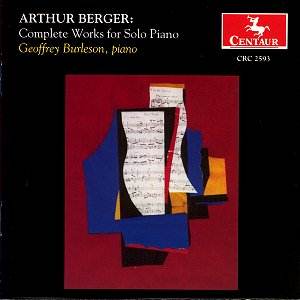Centaur's catalogue is valuable but little sung. It
is a delight to write about this disc and about a composer who has had
hardly any attention from the record companies.
Berger was born in New York City. His style evolved
from dodecaphony to neo-classical to serial. He was educated in schools
in the Bronx. Knowledge about music during his high school years was
soaked up from scores and music books. He soon began writing music.
At New York University he teamed up with Jerome Moross and Bernard Herrmann.
Through them he discovered Ives, Cowell and Varèse. His Two
Episodes is a souvenir of those days when Schoenberg was the god
of the 'Young Composers' group. The rigour of the Schoenbergian method
was soon rejected. He took up music criticism and teaching, then travelled
to Paris on a Paine travelling fellowship. Contact with Milhaud accounts
for a neo-classical phase during the late 1930s and 1940s. The 1950s
into the 1960s saw a further sea-change with the move to serialism which
reached its zenith in his string quartet (1958). His compositions in
the 1960s and since have been freer - moving easily from and to serialism
- but still tough.
The Episodes are not the rigidly structured
pieces we might have feared. If the Poco adagio is rather desiccated
the Scherzando does not lack for jazzy juiciness and neither
does the Allegro molto. These twelve tone pieces play for no
more than 4½ minutes in total.
Almost a decade on and the Fantasy is a sanguine
blend of jazzy positivism and fragmentation. Three years later the Rondo
is a pleasing piece with melody playing an important part as it does
in the Fantasy. Three Bagatelles are again delightful
for both their dissonance and their tonal resource. The Partita
is in five movements in which dissonance, fragmentation of line and
popular music fuse and melt.
The Inventions date from the period 1948 to
1954. Some carry a Bachian implication (Lento and Leggiero
tr. 16, 17). By 1969 he was back to 12-tone writing. On this disc
the Five Pieces (Schoenbergian title too!) defiantly espouse
the dodecaphonic cause. Be warned - this is firmly in the skittering,
scatty, plink-plunk mode. While Copland-like effects float free from
many of the other works this is tough indeed. The Birthday Cards,
products of the 1980s and 1990s, are mined from the same refractory
lode.
By no means easy music though the earlier tracks are
more approachable than the later. The writing is concise with many pieces
playing less than two minutes. Geoffrey Burleson is a doughty and highly
sympathetic advocate for Berger's music. I am sure the composer must
be delighted with his disc which is also extremely well documented by
the pianist.
Rob Barnett
